| the iPhone | |
| June 2007 | |
| Nokia Siemens Networks | |
| April 1, 2007 | |
| the NSA call database scandal | |
| May 2006 | |
| videoblog | |
| 2005 | |
| VeriChip is a Radio Frequency IDentification device | |
| 2005 | |
| SkyDSL | |
| 200? | |
 |
Wi-Fi |
| 2004 | |
|
|
newscorp |
| November 12, 2004 | |
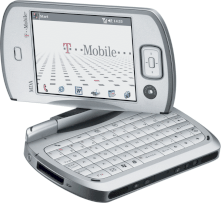 |
smartphones began to make up an increasingly large part of the mobile phone market
|
| 2004 | |
| 2003 | |
| 2003 | |
| 2003 | |
|
WorldCom went bankrupt |
|
| July 21, 2002 | |
| 200? | |
| 200? | |
| 2002 | |
| January 2002 | |
|
300,000,000 computers on the Internet |
|
| 2001 | |
| April 1, 2001 | |
| January 11, 2001 |
AOL purchased Time Warner Time Warner was created in 1990 by the merger of Time Inc. and Warner Communications |
|
ASIMO is a humanoid robot |
|
| 2000 | |
|
Napster was the first peer-to-peer file sharing network |
|
| 1999 | |
| September 1999 | |
|
ADSL was introduced in many countries with downstream rates starting at 256 kbit/s and 8 Mbit/s as the current maximum transfer speed |
|
| 1999 |
|
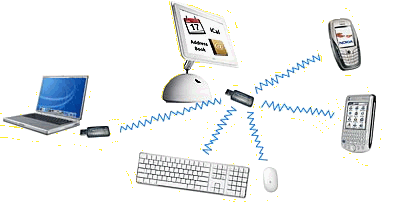 |
Bluetooth is an industrial specification for wireless personal area networks
|
| May 20, 1999 |
|
|
Iridium communications service |
|
| November 1, 1998 |
|
|
The Highwaymen Ken Auletta |
|
| 1998 | |
|
the Digital Millennium Copyright Act |
|
| October 28, 1998 | |
|
News of the Lewinsky scandal first broke on the Drudge Report website, which reported that Newsweek editors were sitting on a story by investigative reporter Michael Isikoff exposing the affair |
|
| January 17, 1998 |
|
| 1996 | |
| November 1996 | |
| July 4, 1996 |
|
|
the Apache HTTP Server became the most popular server on the net |
|
| April 1996 | |
|
the Palm Pilot PDA was released |
|
| 1996 | |
|
Telecommunications Act |
|
| February 8, 1996 | |
|
Dragon released discrete word dictation-level speech recognition software. It was the first time dictation speech recognition technology was available to consumers. IBM and Kurzweil followed a few months later. In 1997 Dragon introduced "Naturally Speaking", the first "continuous speech" dictation software available (meaning you no longer need to pause between words for the computer to understand what you're saying) |
|
| 1995 | |
|
VeriSign is a company that operates a diverse array of network infrastructure, including two of the Internet's thirteen root nameservers |
|
| 1995 |
|
| 1995 | |
|
Kevin Mitnick was arrested by the FBI |
|
| February 15, 1995 | |
|
the NSFNET Backbone Service, operating since 1987, was successfully transitioned to a new architecture, where traffic is exchanged at interconnection points called Network access points |
|
| April 30, 1995 |
|
| 1994 | |
|
America Online announced that it had reached 1 million subscribers |
|
| 1994 | |
|
Justin Hall who began eleven years of personal blogging while a student at Swarthmore College, is generally recognized as one of the earliest bloggers. The term "weblog" was coined by Jorn Barger in December 1997 |
|
| 1994 | |
|
|
the World Wide Web Consortium creates standards that Web developers should try to conform to, in order to maximize the ability of others to access their Web sites |
| 1994 | |
|
online editions of the major newspapers |
|
| 1990s | |
|
|
the World Wide Web Wanderer was a perl based web crawler that was first deployed to measure the size of the World Wide Web. The Software was developed at MIT by Matthew Gray. Later in 1993, it was used to generate an index called the "Wandex", providing the first search engine on the web |
| June, 1993 | |
| March 1993 | |
| 1993 | |
| 1992 | |
 |
the Internet Society is the parent corporation of the Internet Architecture Board and the Internet Engineering Task Force |
| 1992 | |
|
Ipswitch released Ws_ftp |
|
| 1992 | |
| 1991 | |
 |
the SupraFax 14400 ran at the 14.4 kbit/s rate
|
| 1991 | |
 |
|
| 1991 | |
 |
second generation mobile phone systems such as GSM, IS-136 ("TDMA"), iDEN and IS-95 ("CDMA") began to be introduced. The first digital cellular phone call was made in the United States in 1990, in 1991 the first GSM network opened in Europe
|
| 1991 | |
| 1990 | |
| 1990 | |
|
the Hubble Space Telescope was put in space by pace NASA's Space Shuttle Discovery |
|
| April 4, 1990 | |
|
the www as well as http, html and urls were invented by Tim Berners-Lee at Cern |
|
| 1990 | |
| 1990s | |
|
the first of 24 satellites that form the current GPS constellation (Block II) was placed into orbit. The 52nd GPS satellite since the beginning in 1978 was launched November 6, 2004 aboard a Delta II rocket |
|
| February 14, 1989 | |
|
the first dial-up internet service provider was world.std.com |
|
| 1989 | |
| 1988 | |
|
most dialup modems follow the Hayes Command Set it was originally developed for the Hayes Smartmodem 2400 |
|
| 1988 | |
| 1987 | |
|
the File Transfer Protocol was first developed in 1971 for implementation on hosts at M.I.T. In 1985 ftp was defined by the RFC 959 documnet |
|
| October 1985 | |
|
the Domain Name System was introduced by Paul Mockapetris. Symbolics.com became the first registered commercial domain name |
|
| 1984 | |
| 1980s | |
| 1983 | |
|
the TCP/IP protocol began to be used for ARPAnet and the Defense Data Network |
|
| January 1, 1983 | |
| :-) | |
| 1982 | |
| 1980s | |
 |
the first cell phone network with automatic roaming was started in Saudi Arabia
|
| September 1981 | |
| 1980 | |
| 1980s | |
| 1980s | |
| early 1980s | |
|
the first commercial cellular telephone network was installed in Tokyo by NTT |
|
| 1979 | |
| 1979 | |
 |
UUCP stands for Unix to Unix Copy Protocol, and is a computer program and protocol allowing remote execution of commands and transfer of files, email and netnews between Unix computers not connected to the Internet proper. In 1979 Tom Truscott and Jim Ellis of Duke University created Usenet a distributed Internet discussion system that evolved from a general purpose UUCP network. Now widely recognized concepts and terms such as "FAQ" and "spam" were originated on the usenet
|
| 1978 | |
|
the Foreign Intelligence Surveillance Act |
|
| 1978 | |
 |
|
| 1975 | |
| 1970s | |
| 1970s | |
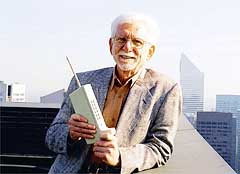 |
modern mobile telephony is considered to have started when Motorola employee Martin Cooper placed a call to rival AT&T's Bell Labs while walking the streets of New York City talking on Motorola DynaTAC
|
| April 3, 1973 | |
| June 17, 1972-1974 | |
| @ | |
|
the use of the at sign was introduced by Ray Tomlinson. Email had started in 1965 |
|
| 1971 | |
| 1969 | |
| 1966 | |
| 1966 | |
|
country calling codes were defined by the ITU |
|
| 1964 | |
| 1960s | |
| 1960s | |
| 1957 | |
| 1957 | |
| 1950s | |
| December 10, 1951 | |
| June 8, 1949 | |
| 1945 | |
| March 1942 | |
| 1940 | |
| October 30, 1938 | |
| 1934 | |
| 1930s | |
| 1929 | |
|
Edward Bernays' Propaganda |
|
| 1928 | |
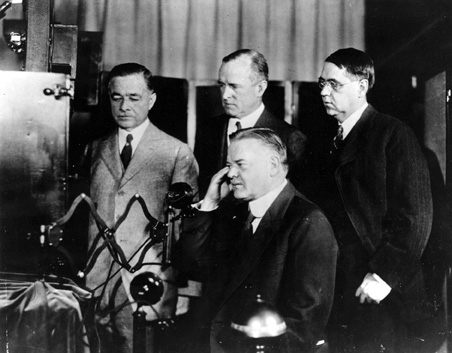 |
the first long distance television transmission was over telephone lines from Washington, DC to New York City. The image shown was of then Commerce Secretary Herbert Hoover
|
| April 7, 1927 | |
| 1927 | |
 |
the Model 12 was the first general purpose teletype
|
| 1922 | |
| 1918 | |
|
the telephone booth became common in industrialized countries in the |
|
| 1910s | |
|
the American Messenger Company was renamed United Parcel Service in 1919 |
|
| 1907 | |
| 1904 | |
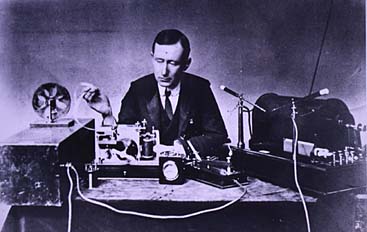 |
Guglielmo Marconi transmitted first long distance communication using electromagnetic or radio waves
|
| December 11, 1901 | |
|
Erfindung der Kathodenstrahlröhre Ferdinand Braun |
|
| 1897 | |
|
Nikola Tesla made the first public demonstration of radio communication |
|
| 1893 | |
|
Heinrich Hertz detects and produces radio waves for the first time. Radio waves are called Hertzian waves until renamed by Guglielmo Marconi, who calls them radiotelegraphy waves |
|
| 1888 |
|
|
AT&T |
|
| March 3, 1885 |
|
| 1878 |
|
|
the first telephone exchange opened in New Haven, Connecticut |
|
| 1878 | |
|
Emile Berliner invented the first microphone on but the first useful microphone was invented by Alexander Graham Bell
|
|
| March 4, 1877 |
|
|
Patentantrag für ein Telefon durch Alexander Graham Bell wenige Stunden vor Elisha Grays Antrag |
|
| 1876 |
|
| 1872 |
|
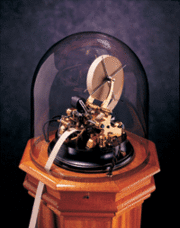 |
|
| 1870s-1960s | |
| May 17, 1865 |
|
|
erster funktionsfähiger Fernsprecher Philipp Reis |
|
| 1861 |
|
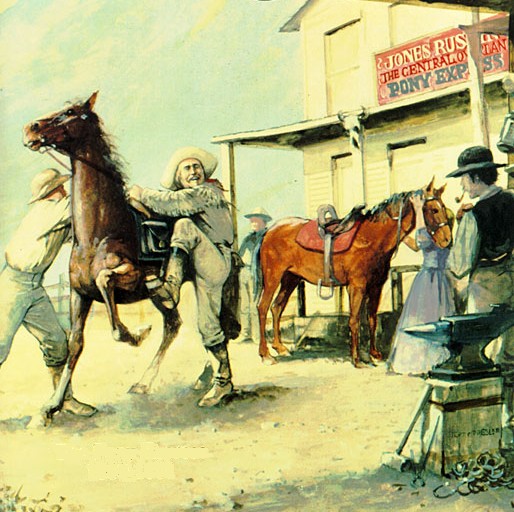 |
|
| April 3, 1860 - August 1861 | |
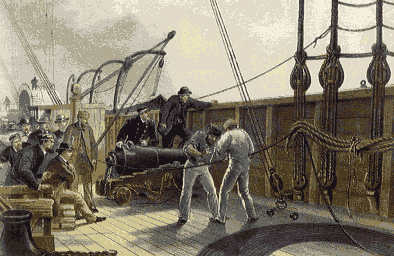 |
the first transatlantic telegraph cable between North America and Europe worked for only one month. It had been laid been laid by Cyrus Field who laid a new, more durable cable in 1866. The first direct transatlantic telephone cable was laid by Werner von Siemens in 1875
|
| 1858 |
|
|
the British Post Office first encouraged people to install letter boxes to facilitate the delivery of mail |
|
| 1849 |
|
| 1848 | |
|
Samuel Morse sent the telegraph message "What hath God wrought" from the Supreme Court room in Washington, D.C. to his assistant, Alfred Vail, in Baltimore, Maryland
|
|
| May 24, 1844 |
|
|
the first commercial electrical telegraph was constructed by Sir Charles Wheatstone and Sir William Fothergill Cooke. It used the deflection of needles to represent messages and started operating over thirteen miles (twenty-one kilometres) of the Great Western Railway |
|
| April 9, 1839 |
|
|
Samuel Morse independently developed an electrical telegraph |
|
| 1837 |
|
| 1835 |
|
 |
Agence Havas was founded as the first news agency in the world. Today it is known as Agence Française de Presse
|
| 1835 |
|
| 1834 |
|
| 1830s |
|
| 1684 |
|
| 17th century |
|
|
the first printed newspaper was published |
|
| 1605 |
|
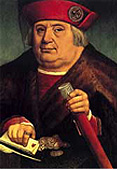 |
Franz von Taxis established the Reichspost
|
| 1495 |
|
|
|
|
| ca. 300 bc |
|
|
following the advice of Li Si, Qin Shi Huang ordered all philosophy books and history books from states other than Qin to be burned |
|
| 213 bc |
|
|
|
|
|
|
|
|
|
|
 |
|